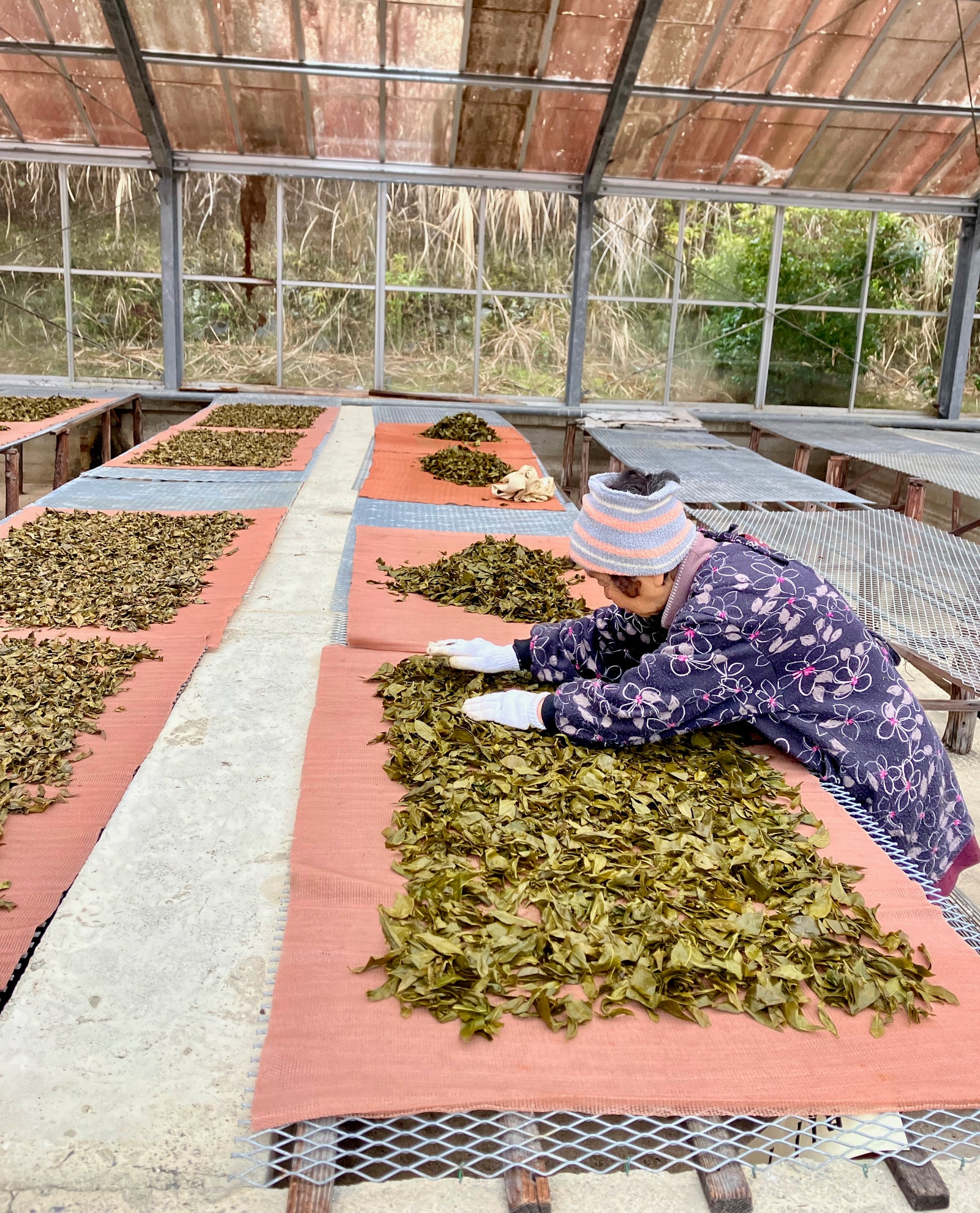宍喰町は徳島県の最南端、海陽地区にあります。その名の通り、海が豊かな「海の町」です。サーフィンやダイビングの名所としても有名です。また、四国遍路の巡礼の際には、この町を通過することもあるでしょう。しかし、この地域は山の恵みも豊かで、実はこの地域の銘茶「山茶」があるのです!

この貴重なお茶は「宍夷寒茶」と呼ばれ、現在では郭村で茶農家の石川明美さん(2024年時点で87歳)によってのみ栽培されています。郭村は宍夷市街地から車で約40分の距離にあります。寒茶は、一年で最も寒い時期に収穫される伝統的な民俗茶です。かつてこの地域では、主に自家用として、また販売用としても、多くの人々が寒茶を作っていました。しかし、この独特な民俗茶を作る他の生産者たちは高齢化に伴い茶作りをやめ、現在では明美さんだけが伝統を守っています。
2月上旬、私たちは明美さんのご自宅と農園を訪問する機会に恵まれました。彼女はちょうど寒茶の収穫の真っ最中でした。この記事では、宍喰寒茶に焦点を当て、明美さん流の寒茶の加工方法についてお話したいと思います。
かん茶作りの工程に入る前に、明美さんについて少しお話を伺いました。明美さんはクオ村で35年以上かん茶を作り続けており、この地域の人々からは「かん茶ばあちゃん」(かん茶のおばあちゃん)という愛称で親しまれています。明美さんは、自分以上にかん茶を愛する人に出会ったことがないとおっしゃっていましたが、彼女が美しいお茶を淹れる様子を目の当たりにすると、その思いが私たちにも伝わってきました。
明美さんにとって、寒茶の収穫期は1月1日頃から始まり、3月10日頃まで続きます。雨天時は収穫できませんが、茶摘み期間中は朝7時から19時まで休みなく働きます。「忙しくしていることが長寿の秘訣の一つ」と明美さんは言います。
明美さんの茶畑は、家のすぐ裏、丘の上の方にあります。最初の写真(下)には、2本の梯子が見えます。これは茶畑へ直結する道です。最初の写真では分かりにくいですが、2枚目の写真を見ると、明美さんの茶畑がかなり広大で、段々畑に沿って上に向かって広がっていることが分かります。


宍夷寒茶は、郭村の山間に自生する開放受粉の茶樹から作られています。ここの水も非常に良質だと言われています。
お茶が作られる前、これらの棚田では何が栽培されていたのか興味があったので、明美さんに教えていただきました。当時は米が栽培されていたそうで(明美さんは現在も米を栽培していますが、低い棚田の一つで栽培しています)、茶の木はここに植えられたものではなく、ある時期から自然に生えてきたものだとのことです。明美さんによると、野ネズミが落ちた茶の木の種をまき、それが茶の普及につながったそうです(このことについては以前の寒茶の記事でも触れましたが、もし日本語が理解できて読めるなら、明美さんがここでもユーモアたっぷりにこの話をシェアしています)。明美さんの茶畑は現在1,000 坪(約0.82エーカー)あります。
獅子吼寒茶づくり
驚くべきことに、茶摘みはすべて手作業で行われています。彼女の茶畑は、まさに自然のままの、野性的な雰囲気を漂わせています。茶樹(在来種)は空に向かって伸び、茶樹の間隔はほとんど空いていません。

茶摘みを体験させてもらいました。明美さんの摘むスピードは、もちろん私たちとは比べものになりません(朝日新聞に掲載された明美さんのカンチャ摘み動画)。明美さんは、茶摘みの音を聞きながらフロー状態に入るのだそうです。1日に収穫できるお茶の量はたったの4kg。明美さんのような熟練者でなければ、もっと少ない量です。
茶葉を摘み終えると、明美さんは縁側(伝統的な日本家屋によく見られる、庭に面した床の延長部分で、座ったり通路を通ったりする場所)に広げ、未熟な葉や枝などを取り除きます。これは茶葉をかき混ぜ、不要なものを取り除く選別作業です。

その後、茶葉を25分間煮出します。明美さんはキッチン脇の小さなスペースでこの作業を行います。デジタル時計を見ながら25分を計りながら、他の用事を済ませている時でも、カンチャのことを忘れたことはないと話してくれました。

 左:25分茹でて冷めるカンチャの葉。右:笑顔で話しかけてくれる明美さん。彼女の笑顔は、農家だった祖母を思い出させました。
左:25分茹でて冷めるカンチャの葉。右:笑顔で話しかけてくれる明美さん。彼女の笑顔は、農家だった祖母を思い出させました。
蒸した茶葉を外気で少し冷ました後、明美さんはこの使い込まれた機械を使って、成熟して硬くなった茶葉から旨みを抽出します。この機械を手に入れるために、明美さんは隣町の農家を訪ねたそうです。この機械が動いている様子は、スタジオジブリの『千と千尋の神隠し』の登場人物、釜爺を彷彿とさせました(関連性が感じられなくてもご安心ください)。

最後の仕上げとして、明美さん自ら茶葉を揉みほぐします。茶葉に人の気を込めることが大切だと明美さんは言います。昔はすべて手作業で丁寧に揉まれていたそうです。

茶葉を揉み込んだ後、古い木桶に24時間漬け込みます。この木桶は彼女の母親から受け継いだものです。

翌日、茶葉はバケツから取り出され、明美さんの温室に運ばれ、2~5日間広げられて乾燥させられます。乾燥時間は天候によって異なります。普段(お客さんがいない日)は、明美さんは茶葉を手押し車に積み込み、橋を渡った先にある温室まで歩いて行くと聞いて、私たちは驚きました。歩くことで少し運動になるのだそうです。
彼女の温室について、もう一つ興味深い事実があります。どうやら、この温室はもともとスッポン(つまり食用)の飼育に使われていたそうです。ところが、放置された後、明美さんの温室になったのです。カンチャの葉を乾燥させるのにぴったりです。明美さんは、温室のどこかに修理が必要になったら、村や近隣の村の人に頼めると言っていました。彼女は、この温室は幸運な発見だったと言っていました。

最後に、葉は屋外に運ばれ、乾燥されます。クオ村での滞在時間は限られていたため、この最終工程を見る機会はありませんでした。それでも、明美さんは、最後の天日干しはカンチャ作りにおいて非常に重要だと言います。太陽のエネルギーを受け取ることには特別な意味があるのだと。
明美さんのおかげで、ご自宅のすぐ外で、美しい茶畑を見渡しながら、美味しいかんちゃを味わうことができました。郭村の山の水を使い、明美さん自ら淹れたかんちゃは、まさに特別なご馳走でした。私たちを温かく迎え、かんちゃへの情熱を共有してくださった明美さんに心から感謝いたします。
かんちゃばあちゃん(明美さん)については後ほど詳しく記事をアップしますので、お楽しみに。
何か他にご意見やご質問がございましたら、お気軽に下記にコメントやご質問を投稿してください。または、私(Moé Kishida)まで直接ご連絡ください:moe@yunomi.life。ありがとうございます!


